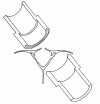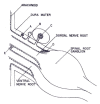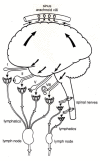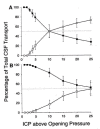The function and structure of the cerebrospinal fluid outflow system
- PMID: 20565964
- PMCID: PMC2904716
- DOI: 10.1186/1743-8454-7-9
The function and structure of the cerebrospinal fluid outflow system
Abstract
This review traces the development of our understanding of the anatomy and physiological properties of the two systems responsible for the drainage of cerebrospinal fluid (CSF) into the systemic circulation. The roles of the cranial and spinal arachnoid villi (AV) and the lymphatic outflow systems are evaluated as to the dominance of one over the other in various species and degree of animal maturation. The functional capabilities of the total CSF drainage system are presented, with evidence that the duality of the system is supported by the changes in fluid outflow dynamics in human and sub-human primates in hydrocephalus. The review also reconciles the relative importance and alterations of each of the outflow systems in a variety of clinical pathological conditions.
Figures














Similar articles
-
Lymphatic drainage of cerebrospinal fluid in mammals - are arachnoid granulations the main route of cerebrospinal fluid outflow?Biologia (Bratisl). 2018;73(6):563-568. doi: 10.2478/s11756-018-0074-x. Epub 2018 Jun 27. Biologia (Bratisl). 2018. PMID: 30147112 Free PMC article. Review.
-
Cerebrospinal fluid outflow: a review of the historical and contemporary evidence for arachnoid villi, perineural routes, and dural lymphatics.Cell Mol Life Sci. 2021 Mar;78(6):2429-2457. doi: 10.1007/s00018-020-03706-5. Epub 2021 Jan 11. Cell Mol Life Sci. 2021. PMID: 33427948 Free PMC article. Review.
-
Overview of the CSF dual outflow system.Acta Neurochir Suppl. 2012;113:47-50. doi: 10.1007/978-3-7091-0923-6_10. Acta Neurochir Suppl. 2012. PMID: 22116422 Review.
-
Pathways of cerebrospinal fluid outflow: a deeper understanding of resorption.Neuroradiology. 2015 Feb;57(2):139-47. doi: 10.1007/s00234-014-1461-9. Epub 2014 Nov 16. Neuroradiology. 2015. PMID: 25398655
-
Anatomy and physiology of cerebrospinal fluid.Eur Ann Otorhinolaryngol Head Neck Dis. 2011 Dec;128(6):309-16. doi: 10.1016/j.anorl.2011.03.002. Epub 2011 Nov 18. Eur Ann Otorhinolaryngol Head Neck Dis. 2011. PMID: 22100360 Review.
Cited by
-
Clearance systems in the brain-implications for Alzheimer disease.Nat Rev Neurol. 2015 Aug;11(8):457-70. doi: 10.1038/nrneurol.2015.119. Epub 2015 Jul 21. Nat Rev Neurol. 2015. PMID: 26195256 Free PMC article. Review.
-
Research into the Physiology of Cerebrospinal Fluid Reaches a New Horizon: Intimate Exchange between Cerebrospinal Fluid and Interstitial Fluid May Contribute to Maintenance of Homeostasis in the Central Nervous System.Neurol Med Chir (Tokyo). 2016 Jul 15;56(7):416-41. doi: 10.2176/nmc.ra.2016-0020. Epub 2016 May 27. Neurol Med Chir (Tokyo). 2016. PMID: 27245177 Free PMC article. Review.
-
Mechanisms of fluid movement into, through and out of the brain: evaluation of the evidence.Fluids Barriers CNS. 2014 Dec 2;11(1):26. doi: 10.1186/2045-8118-11-26. eCollection 2014. Fluids Barriers CNS. 2014. PMID: 25678956 Free PMC article. Review.
-
Aging Is Positively Associated with Peri-Sinus Lymphatic Space Volume: Assessment Using 3T Black-Blood MRI.J Clin Med. 2020 Oct 19;9(10):3353. doi: 10.3390/jcm9103353. J Clin Med. 2020. PMID: 33086702 Free PMC article.
-
Cerebrospinal fluid drainage through the diploic and spinal epidural veins.J Anat. 2015 Sep;227(3):297-301. doi: 10.1111/joa.12349. Epub 2015 Jul 16. J Anat. 2015. PMID: 26184099 Free PMC article.
References
-
- Trolard D. Les Lacunes Veineuses de la dura-mere. J de L'anatomie. 1892;38:28–56.
-
- Davson H, Segal MB. Physiology of the Cerebrospinal Fluid and Blood-Brain Barriers. London: CRC Press; 1996.
-
- Key A, Retzius G. Studien in der Anatomie des Nervensystems und des Bindegewebes. Stockholm: Samsin and Wallen; 1875.
LinkOut - more resources
Full Text Sources
Other Literature Sources

